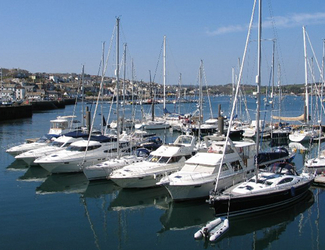stay guide cornwall

Falmouth
There were no buildings in Falmouth, apart from the home of the Killigrew family, Arwennack, until the middle of the sixteenth century. Henry VIII later built Pendennis Castle on the headland, and the town developed from there. The Falmouth Packets used to dispatch mail all over the world. In the 1820s, the Admiralty took over the role of mail delivery. Falmouth has the world's third largest natural harbour and annually hosts many international sailing events. The town also has four large sandy beaches which are all popular with families. Pleasure boats can be taken up the River Fal from the Prince of Wales Pier, and a ferry runs across to St Mawes, where another castle stands. Falmouth has a wide selection of shops, cafes, pubs and restaurants. There is also the Ships and Castles Leisure Pool, the Maritime Museum and the Falmouth School of Arts. The Falmouth Arts Centre regularly screens films old and new, and the Princess Pavilion hosts many varied shows and performances throughout the summer. The Pavilion is set among the sub-tropical Gyllyngdune gardens. There are three other gardens in Falmouth - Fox Rosehill, Queen Mary and Kimberley Park - although Trelissick, Trebah and Gendurgan gardens are all nearby. There is a flight of 111 steps just off the Moor, known as Jacob's Ladder. Upon reaching the top, fantastic views of Falmouth can be enjoyed. Each August, the town hosts Henri Lloyd Falmouth Week - this week long event includes competitive dinghy and yacht racing as well as performances by tribute bands and party nights.


 Activities
Activities Beach Guide
Beach Guide Entertainment
Entertainment Food and Drink
Food and Drink Places of Interest
Places of Interest Shopping
Shopping Holiday Services
Holiday Services